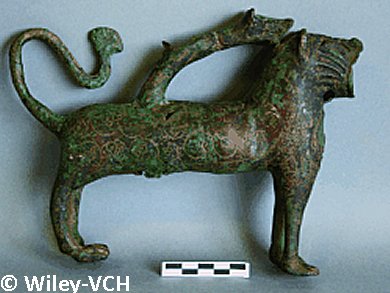Date Archeological Artifacts if Carbon Dating Method Does not Apply
How can the age of archeological objects be determined if the well-established carbon dating method does not apply, for example for metal objects? Spanish and Portuguese scientists have introduced a technique for dating artifacts made of copper and bronze. Presented in the journal Angewandte Chemie, their electroanalytical method is based on the voltammetry of microparticles. It compares various corrosion products that form over long periods of time and works with only a few nanograms of material so it causes almost no damage.
Voltammetric experiments produce current–voltage curves that have characteristic shapes for many compounds. In order to date copper-containing, archaeological finds, a team led by Antonio Doménech-Carbó at the University of Valencia examined the ratios of two different copper oxides, tenorite and cuprite, that can be differentiated and quantified based on their voltammetric curves.
When they are exposed to air, copper surfaces become covered by a natural layer of cuprite (Cu2O). Over time, this layer is slowly converted to other products of corrosion. As copper-containing objects age in a slightly corrosive environment, without contact with soils or sea air, a layer of tenorite (CuO) continuously forms over the primary cuprite patina. This occurs because cuprite reacts with oxygen from the air to preferentially form tenorite in an atmosphere containing CO2 or in the presence of calcareous materials. Examination of copper coins by scanning electron microscopy coupled with X-ray spectroscopy confirmed the presence of cuprite and tenorite.
Voltammetry of Microparticles to Date Archeological Artifacts Made of Copper and Bronze
To carry out the electroanalytical experiments, the researchers impregnate a graphite bar electrode with paraffin and dab the surface of the artifact with it. A few nanograms of the sample surface stick to the electrode, which is then dipped into an aqueous electrolyte. This causes almost no damage to the object. Copper oxide microparticles result in very characteristic peaks in the resulting current–voltage curves.
Of particular interest to the researchers is the ratio of the current peaks for tenorite and cuprite. It shows a steady increase with increasing corrosion time, as demonstrated with a series of antique coins from various collections, including the Prehistory Museums of València and Xàtiva, Spain, as well as the artificial ageing of Euro cent coins made of copper. The researchers were able to use the coins to establish a calibration curve that can be used to date objects of unknown age.
The voltammetric dating of a water pitcher from the Caliphal period and a Montefortino helmet from the Roman age gave ages of 1050 ± 80 and 2150 ± 150 years, respectively, which agree well with dates previously established from the archaeological context.
- Dating Archaeological Copper/Bronze Artifacts by Using the Voltammetry of Microparticles,
Antonio Doménech-Carbó, María Teresa Doménech-Carbó, Sofia Capelo, Trinidad Pasíes, Isabel Martínez-Lázaro,
Angew. Chem. Int. Ed. 2014.
DOI: 10.1002/anie.201404522



